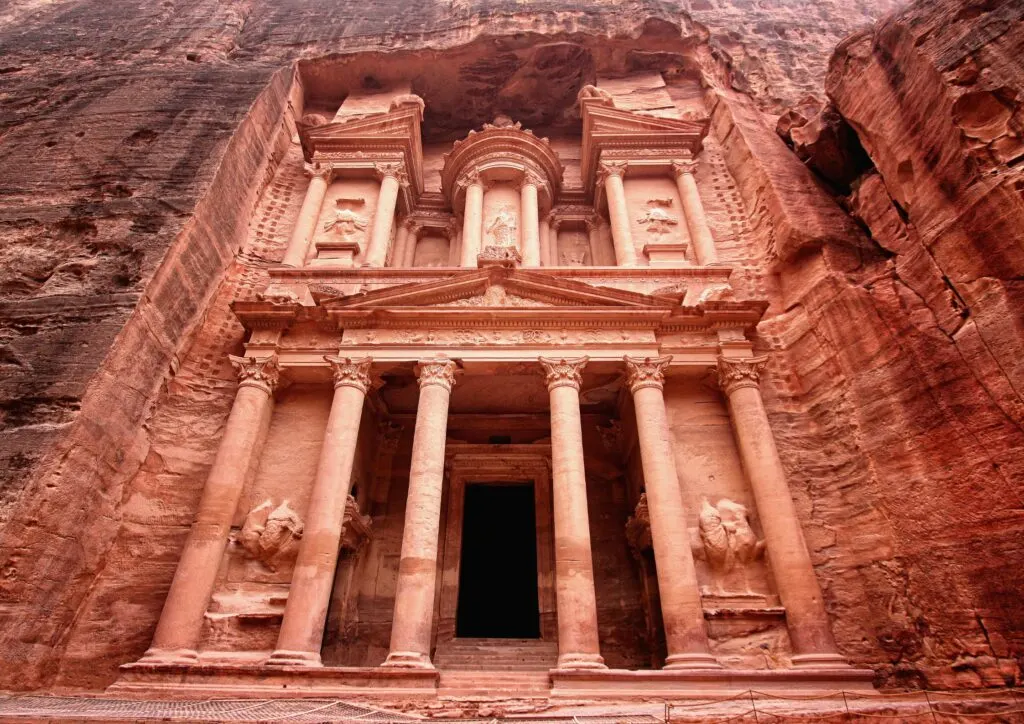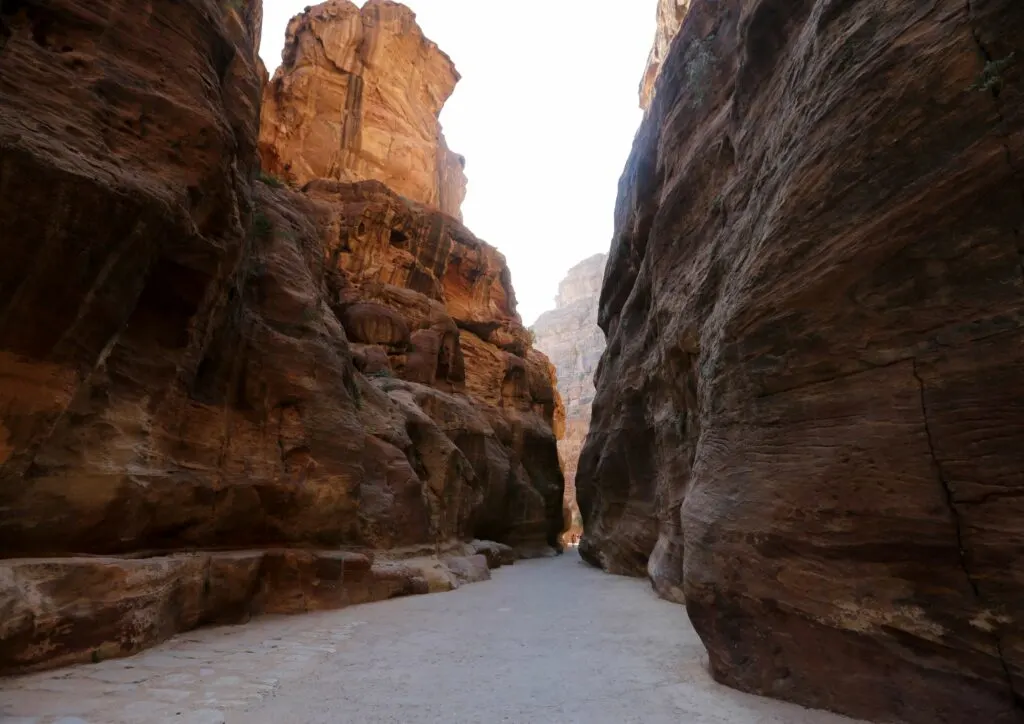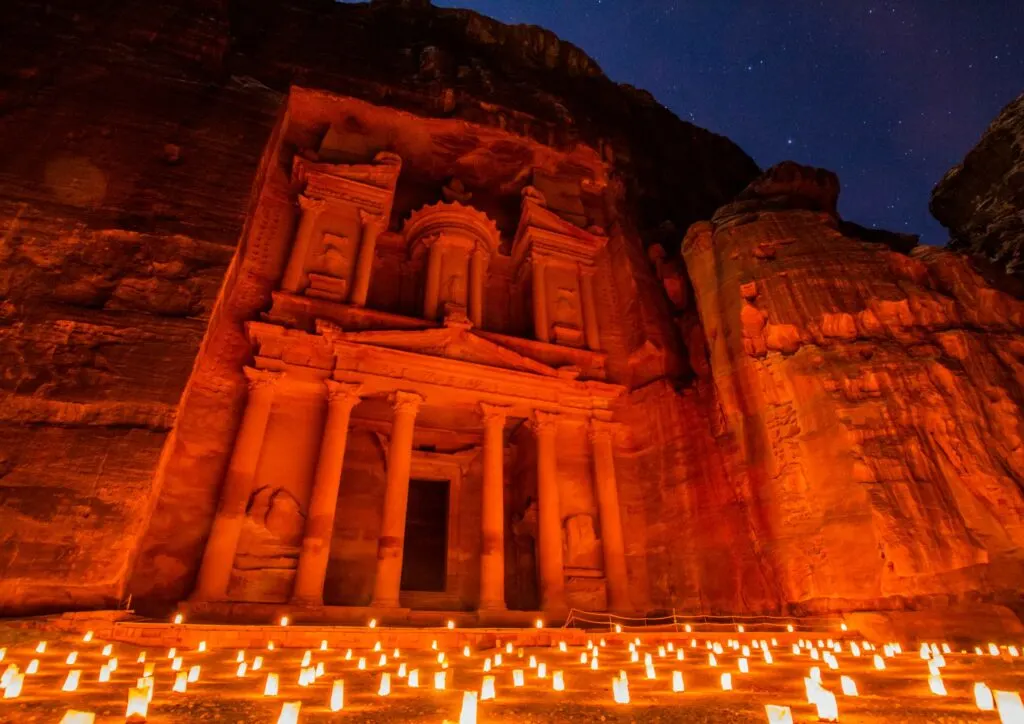Petra has been considered a world wonder since the start of 2000. In many ways, it makes you ponder how a lost city – now one of the most enigmatic archaeological sites in the world, holds a world wonder title all through 2 decades.
We explored this ancient cosmopolitan marvel to find out what exactly makes Petra worthy of being called a world wonder and if it’s truly worth visiting.
Location of Petra
To visit Petra, first, you need to journey to Jordan. The main airport in Jordan is Queen Alia International Airport (AMM) – it’s located 1 hour from Jordan’s capital, Amman – a stunning, culturally and historically rich city.
You can easily find taxis and shuttle services from AMM, so transportation is not a problem. Petra is located approx. 240 kilometres from Amman and Jerusalem. It also falls at the midpoint of the routes to Damascus, the Red Sea and Syria.
If you are a history buff, you’ll immediately recognize that the geographical positioning of Petra contributed to its historic presence as a thriving city.
Petra – Where it All Began
Petra is a city hidden amidst an impenetrable wall of mountains. It was once the homeplace of a native Arab Bedouin tribe called Nabateans – who built this city to its ancient glory.
Thanks to its favourable positioning and engineering wonderments, Petra began to build a reputation as a solid trading post between 400 B.C. and A.D. 106.
However, as the trading routes began shifting, the crowds started to dwindle, and the relevance of Petra began to plummet. For centuries it remained hidden and forgotten till a European traveller entered the ruins in the guise of a Bedouin in the 1800s.
In 1985 Petra was given the UNESCO World Heritage title, and in the 2000s it grew popular as one of the 7 World Wonders.
Petra Tour – What to Expect

Arriving at Petra
Petra is located approximately 3 hours from the capital Amman. So if you choose to take a cab or a private car service, it will take around 3 hours (note- there’s also a free parking space available).
If you are opting out for public transport – like a bus (JETT buses are more commonly used) it will take the same amount of time, and the complete journey will cost around 28 USD.
However, these buses depart around 6.30 a.m.
The Ticket Office
It’s open from 6.00 a.m. to 6.00 p.m. (in the summer) and 6.00 a.m. to 4.00 p.m. (during winter). The ticket cost depends on your tour duration. For instance, a full-day tour can cost around 70 USD, a 2-day tour – roughly 77 USD and a 3-day tour, around 85 USD.
Basically, the longer your tour duration, the more value you get for your ticket price. We, however, only had time to do a one-day tour, so we started our journey pretty early to get a head start from the incoming midday heat.
Once we made it past the entrance, we began our walk along the set trail towards the site. Don’t forget to bring water, a cap/hat(critical), and put on plenty of sunscreen (SPF 50++). There’s not going to be much shade till you enter the Siq.
As you walk your view will be loaded with stunning desert mountain sceneries, the trail honestly looks otherworldly even before you enter Petra.
It honestly made us feel like we’ve stepped into another realm, like a scene straight out of the movie Dune.
The Siq

As we come closer to the Siq – the dramatic passageway into the lost city, the path goes from spacious to super narrow.
The giant mountains close in on you, creating a super shady yet lean path. You’ll notice many ancient, faded carvings on the rocks, remnants of a grand old civilisation – including old drain systems that carried water into the city. It’s merely the start of wonderment.
*Route length- roughly 1.5 kilometres
The Treasury (“Al’Khazne”)
As you reach the end of the Siq, you get a glimpse of the city, and this alone is enough to amaze anyone.
As we entered, we found ourselves face to face with the Treasury. Its grandeur hits you almost instantly. The sunlight washes all over the structure, and it only adds to the effect, making the moment more surreal.
The columns and their intricate rock carvings exude resplendence even in their ruined state and make the rosy surface glow. It’s incredible.
As we explored, we found out that it was called the Treasury because nomadic tribes believed it was filled with gold coins.
While efforts were made to retrieve this said gold, none were found, what is left now is solid rock.

The Amphitheatre
We followed the narrow canyon path, which was the main street back then, towards the ancient Hellenic-style theatre. As you walk, you’ll pass an unending succession of tombs and ruins on either side, it certainly slowed us down as we were too busy taking in the countless sceneries before us.
The rock cuts on these facades are clean and smooth. The Nabatean artisans have carved with such expertise that the rocks in their exterior and interior reveal a marble effect that has lasted the tests of time.
As we reached the theatre, we instantly noticed that unlike the amphitheatres found in Greece and Rome, this particular theatre was carved entirely out of rock. Not surprising, yet it still blows your mind.
A nearby tour guide was explaining how it can seat almost 8000 people.
Qasr al-Bint Temple
After a snack and a break, we continued, tired yet pumped, to the ancient temple, which once was the primary place of worship for Nabateans.
This ancient structure was a free-standing building with an enormous doorway leading into the temple. With no roof and super dilapidated columns, it left behind an idea of the grandeur it once carried in an ancient time.
Fun fact: In ancient times the temple was dedicated to the deity Dushara – the God of the Mountain.
The Monastery
After a small break (because the heat does get to you), we made our way to the other side, the northeast of this lost city, to see the final and one of the most extraordinary sites – The Monastery a.k.a. the Ad-Deir.
The strength to climb is essential for this next one because it’s at the summit of one of the tallest mountains in Petra. As you hike up the rocky trail, the heat gets stronger – But the winds are a welcome change.
The view, however, steals your complete attention. It makes you forget how exhausted you are. It’s unearthly – nothing we’ve ever seen could match up to it. It takes roughly 45 minutes to climb depending on how exhausted you are. But trust us when we say it is worth it!
An immediate glance at the Monastery tells you it has similar carved designs as the Treasury. The columns, symbols etc. but a close observation will show you that it lacks some of the intricate carvings the Treasury has.
We also learned that this was one of the last structures to be inhabited before Petra was utterly abandoned. With that, we began our climb down and trail back after completely satisfying our thirst for exploring this stunning Rose City.
The more we explored, the more we understood – even in its ancient state, it still comes alive to tell you its stories if you look closely.
Frequently Asked Questions About Petra
Can we tour the Petra grounds after night?
Yes. The atmosphere is absolutely magical. Mondays, Wednesdays and Thursdays the Siq and the Treasury are lit by countless candles. The tickets for this special experience can cost around 25 USD; it begins at 8.30 p.m. and ends at 10.30 p.m.
Is there a dress code for visiting Petra?
No, it’s a historical site, not a religious one.
Are there places to grab a snack and beverages inside Petra?
Yes. Both at the visitor centre and throughout the site. As travellers, we strongly believe in supporting local businesses, it may be another holiday destination for visitors but it’s a livelihood for many locals in the area.
Can you go inside the Treasury?
No. it’s an empty chamber.
Are there toilets in Petra?
Yes. In the visitor centre.
What’s the best time to visit Petra?
The spring and Autumn season’s ideal. March, April to May or September to November are the best.
July to August is sunny – but in Jordan, it can get too hot to handle.
What’s the best route to take when travelling to Petra
The Desert Highway – which is the fastest route.
BUT Kings Highway – which is a little longer and delays you by roughly 1.5 hours – is still absolutely panoramic and breathtaking.

